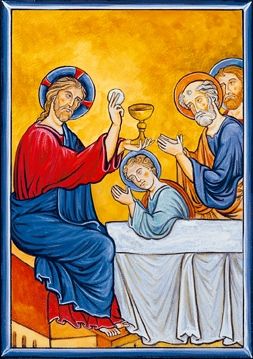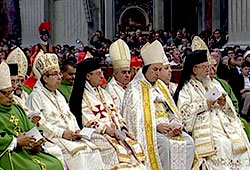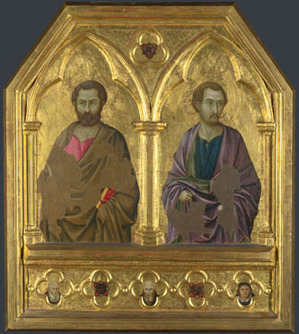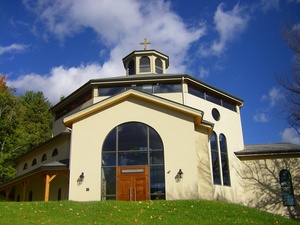Faith in Christ’s Divine Merits
 Some friends and I at the parish have been reading a series of Pope Benedict’s homilies on the Eucharist taken from his book, God is Near Us. I recommend paying attention to every page of this small collection of Benedict’s. Reading through some meditations of Blessed Columba Marmion, the famed Benedictine monk and spiritual master struck me. He wrote,
Some friends and I at the parish have been reading a series of Pope Benedict’s homilies on the Eucharist taken from his book, God is Near Us. I recommend paying attention to every page of this small collection of Benedict’s. Reading through some meditations of Blessed Columba Marmion, the famed Benedictine monk and spiritual master struck me. He wrote,
Synod of Bishops for the Middle East submit propositions to Pope for his consideration
 The bishops at the Synod of Bishops for the Middle
The bishops at the Synod of Bishops for the Middle
East have given the Holy Father the following propositions for his
consideration and perhaps for him to act on when he issues a post-synodal
document. The Synod is now closed and the bishops are on their way home and now it’s time for the Pope and his consultors to do some heavy lifting. The publication of the propositions was approved by the Pope, though they remain unofficial. Some of the propositions are formal, pro-forma and many are so boring
that watching the grass grow is fun.
plate or what I take to be normal, e.g., financial transparency, providing
information in Arabic, being hospitable to immigrants, listening to youth, etc.
Also, what’ve given here you can get a sense of what the churches face in their
situation. What’s evident to a Westerner is that our context in North America is a bit
more advanced, dare I say, than the situation many Middle Eastern Christians face. We already have experience of good
education, dialogue, fruitful collaboration with other faiths, developed
canonical processes. The propositions do raise the point of concern for our sisters and brothers who are Christians in the Middle East.
consideration for a common date for Easter and a better awareness of the role
of the sacred Liturgy in the life of the churches.
Praying for the dead, All Souls
Dominican Sisters of Mary, Mother of the Eucharist to purchase JPII Cultural Center in DC
 Mother Assumpta Long announced last evening that her new congregation of religious sisters, the Dominican Sisters of Mary, Mother of the Eucharist, are hoping to purchase the Pope John Paul II Cultural Center across the street from the Catholic University of America, Washington, DC and using the facility as a house of studies.
Mother Assumpta Long announced last evening that her new congregation of religious sisters, the Dominican Sisters of Mary, Mother of the Eucharist, are hoping to purchase the Pope John Paul II Cultural Center across the street from the Catholic University of America, Washington, DC and using the facility as a house of studies.
Talking about Saint Mary of the Cross MacKillop
 A record number of Australians flocked to Rome last week to attend to the Mass and rites of canonization celebrated by Pope Benedict of 6 people, among them was Australia’s first saint, Sister Mary of the Cross MacKillop. While many will make her the patron saint of the former ex-communicate, she is for me an example of staying faithful to Christ even when ecclesiastics are unusually harsh in their pastoral judgment. For Saint Mary of the Cross for us too, Jesus told us that upon Peter is the Church built; and that’s how we follow Christ: by remaining on that Rock. As her own religious name indicates, “of the Cross,” we ought to carry our cross but with Christ helping us. We don’t go through life alone!!!! The Lord is there with us, right now.
A record number of Australians flocked to Rome last week to attend to the Mass and rites of canonization celebrated by Pope Benedict of 6 people, among them was Australia’s first saint, Sister Mary of the Cross MacKillop. While many will make her the patron saint of the former ex-communicate, she is for me an example of staying faithful to Christ even when ecclesiastics are unusually harsh in their pastoral judgment. For Saint Mary of the Cross for us too, Jesus told us that upon Peter is the Church built; and that’s how we follow Christ: by remaining on that Rock. As her own religious name indicates, “of the Cross,” we ought to carry our cross but with Christ helping us. We don’t go through life alone!!!! The Lord is there with us, right now.
27 Holy Apostles Seminarians take steps toward priesthood
Jesus says to his disciples, ask the Lord to send workers into his harvest (MT 9:38).
Is the doctrine of Original Sin relevant today?
Good question. I am not always confident that the baptized ask this question enough in the lives as Christians. From what I can tell, there seems to be an easy dismissal of anything that requires assent and personal responsibility for our actions, words and thinking. Why? Do we admit there is a sin, that it’s part of the human condition, that it’s handed down from generation to generation? Are we no longer need of redemption? Is humanity’s need for salvation a thing of the past, quaint? Does the fear of God no longer have currency for a relationship with the all-powerful, all-knowing, all-loving God, creator of heaven and earth?
doctrine, interpreted according to the Catholic faith, offers an answer to at
least four questions that are important to both believers and non-believers:
anthropological, philosophical, liturgical, and dogmatic. The article goes on
to examine the role of the Sacred Scripture, the position of Saint Augustine,
of Saint Thomas Aquinas, and the outcomes of the Council of Trent. In
contemporary theology, there exist various tendencies on this theme: original
sin as sin of the world, original sin as psychological and/or social phenomena,
and original sin and the supremacy of the grace of Christ.
Cattolica 2010 IV, pp. 119-132; issue 3848, © copyright.
Communion & Liberation sponsors discussion on peace in the Middle East
The Fraternity of Communion and Liberation sponsored a forum in which the Patriarchs of the Eastern Churches attended and spoke about matter pertaining to peace-building in the Middle East. Notable in attendance were the Mayor of Rome and Italy’s Minister of Foreign Affairs. Patriarch Gregory of the Melkites, one of the most out-spoken Catholic patriarchs, said that if the international community could create the State of Israel it should also work for peace there. The conflicts in Israel and Palestine are destroying the fabric of peace, culture and family. Freedoms are of religion and conscience are not universally respected in all the countries of the Middle East. It was noted that Saudi Arabia gives no freedom of worship and conscience to their inhabitants.
Prayer: raising one’s heart and mind to God
 It would be a pity to forget last Sunday’s first
It would be a pity to forget last Sunday’s first
reading where we read of Moses’ role as mediator of God’s saving plan.
book of Exodus we were reminded that Moses had concern for the salvation of his
unbelieving countrymen, and therefore he asked that God show His compassion
towards sinful Israel (see Exodus 32-34). The raising of Moses’ hands in
prayer, while dramatic, is not a biblical example of a magical Wizard of Oz. It is, however, a posture that invites all of us to pray using our God-given body and as a group as it is more effective in
expanding our own heart for God’s grace and power.
as it is given to us in the Catechism of the Catholic Church cites Saint John
Damascene’s definition of prayer as “…the raising of one’s mind and heart to
God or the requesting of good things from God.” The Catechism speaks of
biblical types of prayer, such as ‘the prayer of Moses [that] responds to the
living God’s initiative for the salvation of His people. It foreshadows the
prayer of intercession of the unique mediator, Christ Jesus’ (2593).
raise our hands in prayer? What posture of prayer do we use? Do we use our body in praying? Are you too stiff and scared in your manner of praying?
the “Nine Ways of Prayer” given to us by Saint Dominic de Guzman is the raising
of hands in prayer. The 6th and 7th Ways of Prayer are directly connected with the living of the Beatitudes and the spirituality of the Cross. Outstretched hands in the form of a cross became a familiar way of praying for Saint Dominic (and his followers) that he believed was inspired by God not only at Mass but also when he was praying for someone’s healing or being being raised from the dead.




